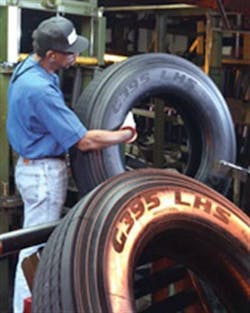Steer tires have it tough. A drive tire can last two to three years while driven as much as 100,000 miles a year. Trailer tires can last even longer. But poor, old steer tires, especially line-haul tires, often wear out a lot sooner. And steer tires for pick-up and delivery applications, where scrubbing and high-impact collisions with curbs are the norm, have even shorter life spans.
“Steer tires are a different animal,” says Guy Walenga, director of engineering, commercial products and technologies, Bridgestone Firestone North American Tire LLC.
While some fleets and owner-operators still take steer tires for granted, truck tire manufacturers are ramping up their investment, experimenting with compounds, construction and tread designs in pursuit of better performance and value.
[PAGEBREAK]
Better fuel economy
“In the past, the big thing was trying to get long, even wear out of steer tires,” says Tim Miller, marketing communications manager, commercial tires, for Goodyear Tire & Rubber Co.
Today, in light of rising operational costs, fleets demand more benefits from steer tires, including the following:
1. Improved fuel economy. With diesel hovering between $4 and $5 a gallon, every mile matters, according to Walenga, who notes that improved fuel economy can be achieved by something as simple as reducing a steer tire’s tread depth.
“You can change it with compounds, you can change it with tread designs, but just reducing tread depth can (boost) fuel economy.”
However, the role of compounding and tread designs cannot be discounted. “Let’s say a trucking company is located where winter traction is not an issue,” Miller proposes. “A lot of them can run a rib tire all the way around, so using a rib-type tire is going to help fuel economy.”
“We’ve taken the road of less tread depth,” says Ron Gilbert, director of commercial products for Toyo Tire U.S.A. Corp. “You get less squirm. Many times, (irregular wear) begins so minutely you can’t see it with the naked eye, but it’s there.”
2. Irregular wear resistance. If irregular wear sets in early, a steer tire’s overall life span will become severely compromised, says Chris Tolbert, business segment manager, Michelin Americas Truck Tires.
“The early onset of irregular wear is what will typically take a tire out of service, especially with free-rolling axles. There’s a lot of potential for scrub.”
[PAGEBREAK]
Directionality helps minimize irregular wear, he notes. “Directionality has worked really well. You can expect to see more of that in future tires,” including the XZA3 AS steer axle-only tire, which Michelin will introduce this December. (The tire replaces the XZA3 AS, which was launched two years ago. It will have “anti-splash” architecture on each side to minimize the kick-up of water.)
“All premium steer tires (for long-haul applications) have some sort of decoupling device,” says Roger Stansbie, director of tire technology, commercial tires, the Americas, for Continental Tire North America Inc.
“Some regional steer tires don’t have decouplers. It’s the boys going up the highway (whose) tires are pounding away at the shoulder,” which can lead to river wear. This type of wear “will eventually creep across the tread.”
It’s best to nip irregular wear in the bud via built-in tire technology, Stansbie continues. “You can slow it down by moving tires across the axle, and I know people who will run the tire until 10/32nds remain and then will put the tire on the trailer. But the real fix is to get a design that will survive the full tread depth.”
“We will continue to see steer tires that will employ any technology they can to figure out how to reduce the occurrence of irregular wear,” says Goodyear’s Miller.
At the same time, with diesel so expensive, few fleet are willing to sacrifice fuel economy, he adds.
“You’re not going to do anything that will reduce your returns... in terms of fuel economy. You’re going to build the tire primarily for rolling resistance.”
[PAGEBREAK]
End user education
As steer tire technology improves, the need to convey features and benefits to end users becomes even more important, say truck tire manufacturers.
“Many years ago, tire manufacturers had the mentality that one size fits all,” says Toyo’s Gilbert. “The key for dealers is to train truck drivers, truck owners and fleets to get them to understand that one size does not fit all. “For example, we (at Toyo) have about five different tread patterns for steer applications, based on what job the tire is doing. Make sure your commercial tire salesperson knows exactly what the tire is going to be used for.
“Whether it’s a commercial tire salesperson or a fleet, many people take the path of least resistance.”
Part of the responsibility rests on the end user, according to Miller. “Encourage your customers to inflate their tires to the to the recommended pressure.” Periodic tire inspections won’t hurt either.



